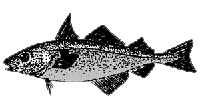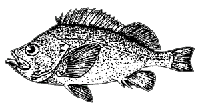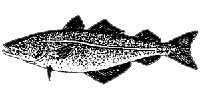
Haddock

|
Although the haddock is a member of the cod family, it differs from the cod in its smaller mouth, longer anterior dorsal fin, and the black line that runs along its side. It is usually about 24 inches long and has a brown back and silvery underside. A black spot is located on each side behind the gills. The haddock travels in large schools and is abundant in the North Atlantic from Iceland to Cape Hatteras.
|
The common names for cod include cod, tomcod and codfish.
Cod have a sleek body, large head, large eyes, blunt snout, and a
distinctive elongated hairlike projection called a barbel below the mouth.
They have three dorsal fins on the back and two anal fins behind the
belly. Cod fish range in color from gray to green but may assume any
number of different shades from brown to red. The scales are small and
smooth and cover the entire body. The lateral line is pale and
distinct.
|
Cod

|
Flounder

|
Flounders come in many different varieties (summer,
winter, greysole, yellowtail, etc.). All flounders have eyes on the same
side of its head although, depending on the species they could be on the
left or right side. The eyed side of the fish is usually dark and the
underside is almost completely white. The flounder may use color
adaptation to match the bottom or in some cases may partially bury itself
as camouflage.
|
Also known as redfish, perch, rosefish, and Norway
haddock, the ocean perch is more orange than red, has a blunt beak and
large eyes. This fish has tough scales that cover its top and sides and a
very spiny dorsal fin. It is usually found at a depth less than 65 meters
and is just one of roughly 68 rockfish species.
|
Ocean Perch

|
Pollock

|
Also known as Boston Bluefish, the pollock is a member of
the cod family. It is very powerful fish and built for speed. Pollock are
shaped like a mackeral and have smooth, shiny scales. They are a dark,
blueish-black across the back and sides, and a grayish-white on the
belly.
|
Also known as the goosefish, the monkfish is easily
recognizable with its flattened body, very large mouth, loose, slimey
skin, and generally disagreeable appearance. A bottom dweller, it lures
unsuspecting prey within reach of its powerful jaws by dangling the fleshy
tip of its dorsal spine enticingly in front of its mouth. The monkfish,
always in demand in Europe and the Orient, has become a very popular
foodfish in North America in the last decade or so.
|
Monkfish

|
Cusk

|
The cusk is a member of the cod family. It has an
elongated body with a dusky white belly and shades of brown and red above.
This fish has large head and mouth, the upper jaw protrudes a little, and
the chin has a barbel. It is easily distinguishable from other members of
the cod family because it has a single dorsal fin. All of the fins are
characterized by a black margin, which is narrowly edged by white.
|
The white hake is also a member of the cod family and in
many ways, resembles the cusk in overall appearance. Like the cusk, it has
an elongated body with a single dorsal fin that goes around the entire
body. The scales are rough-textured and the body color is a grayish-white
with a white underbelly.
|
White Hake

|
|
|